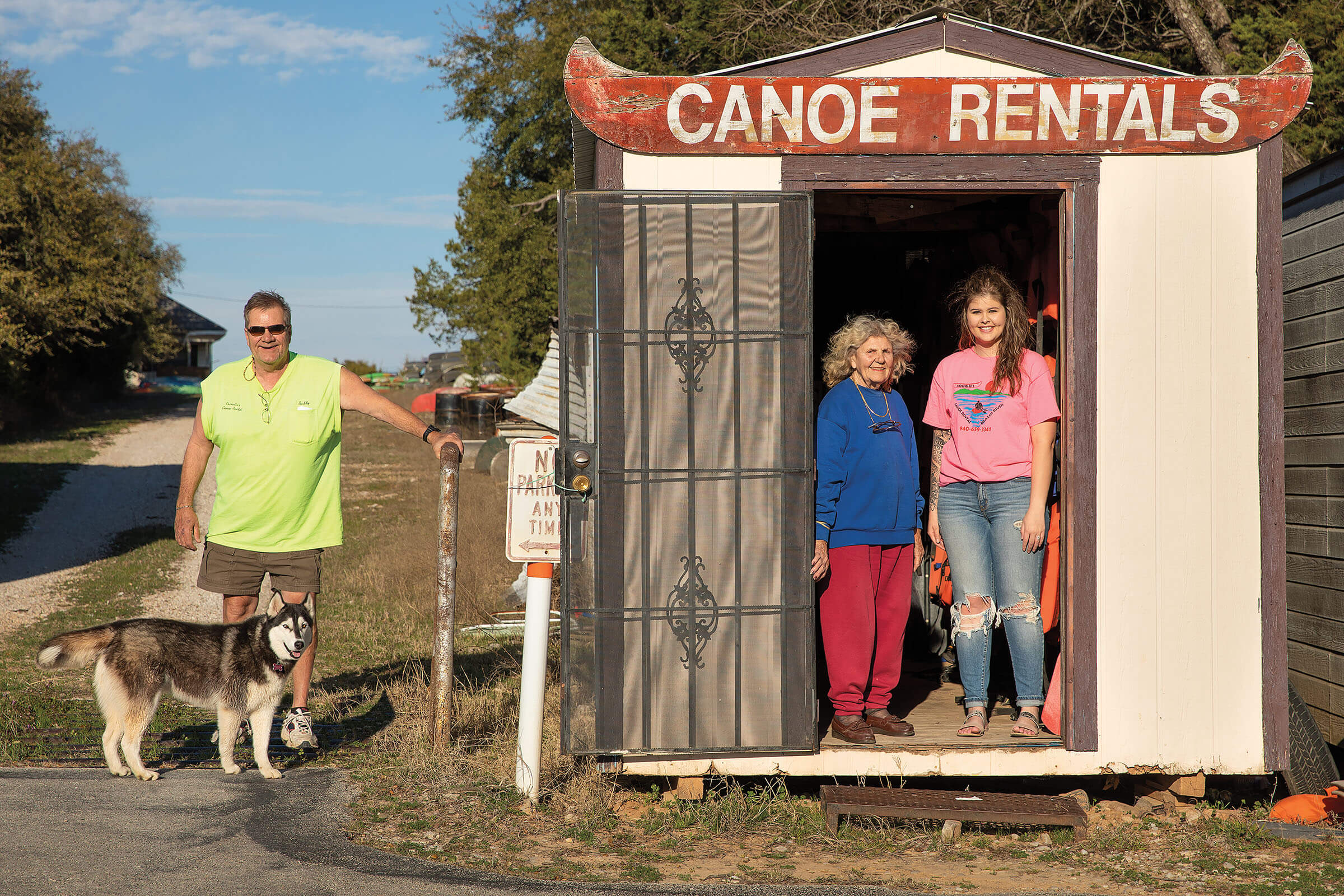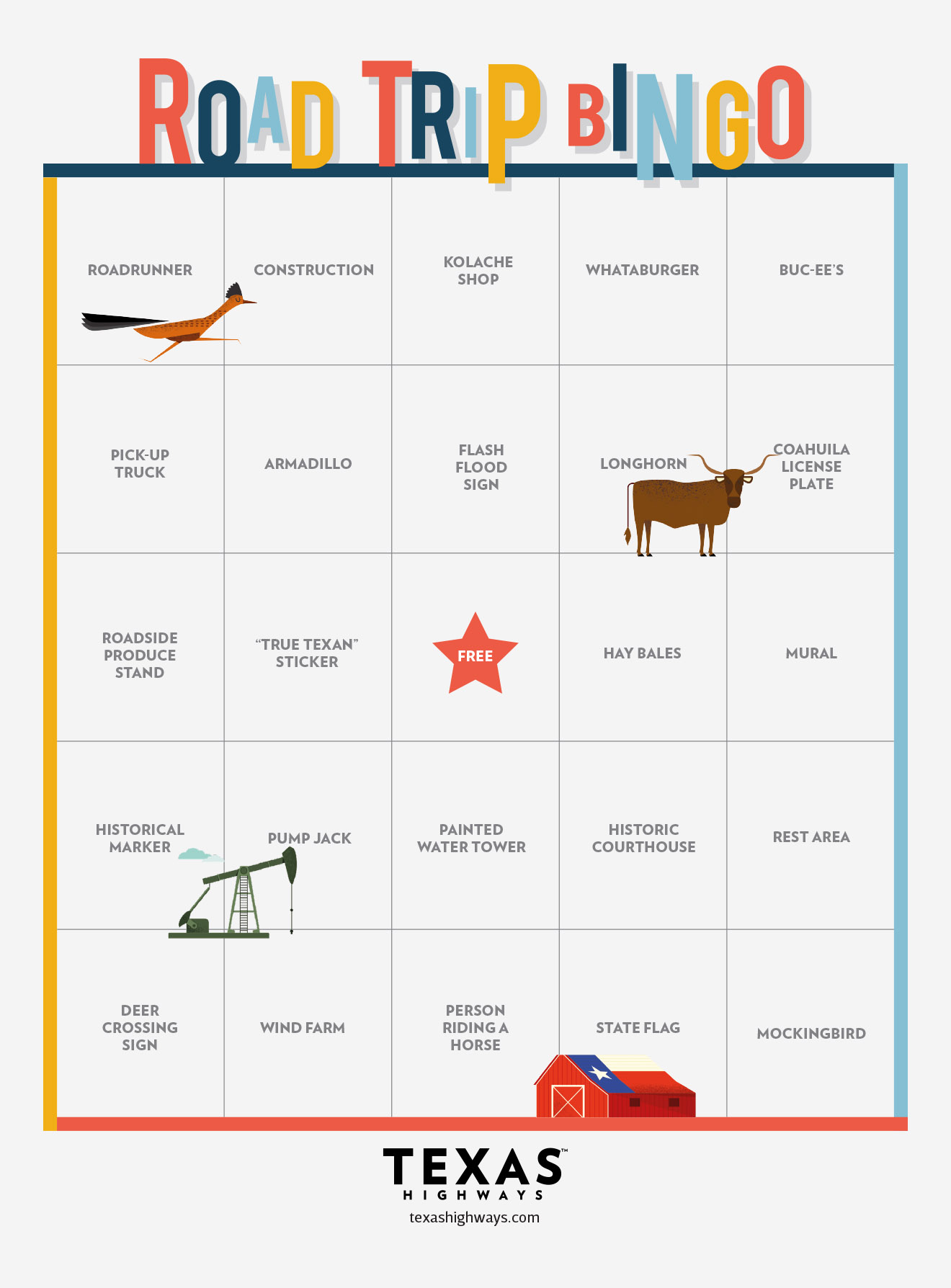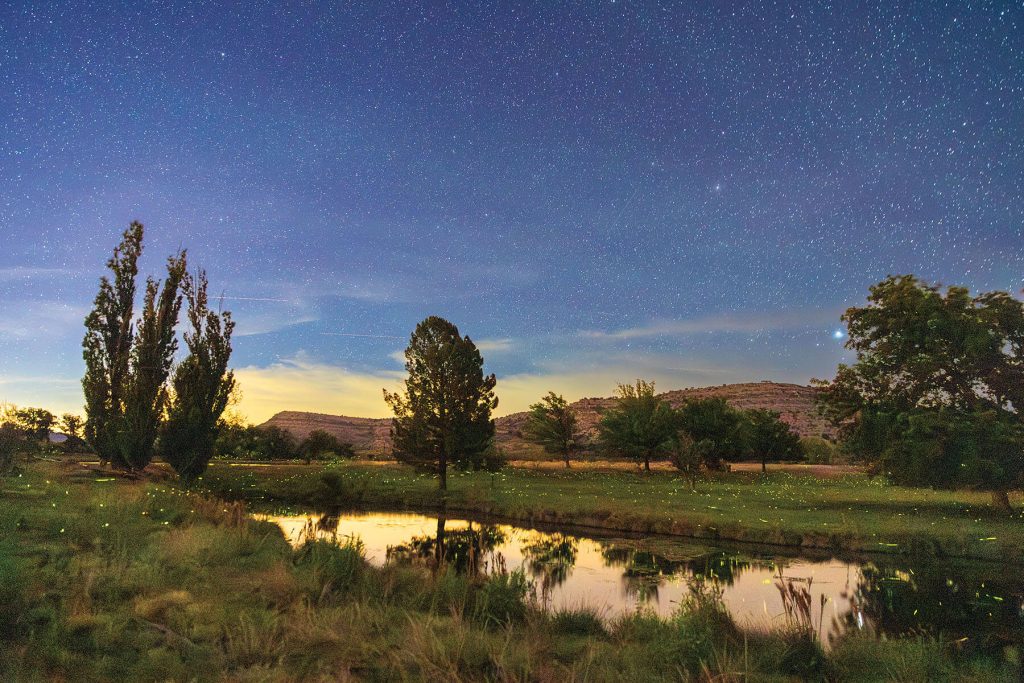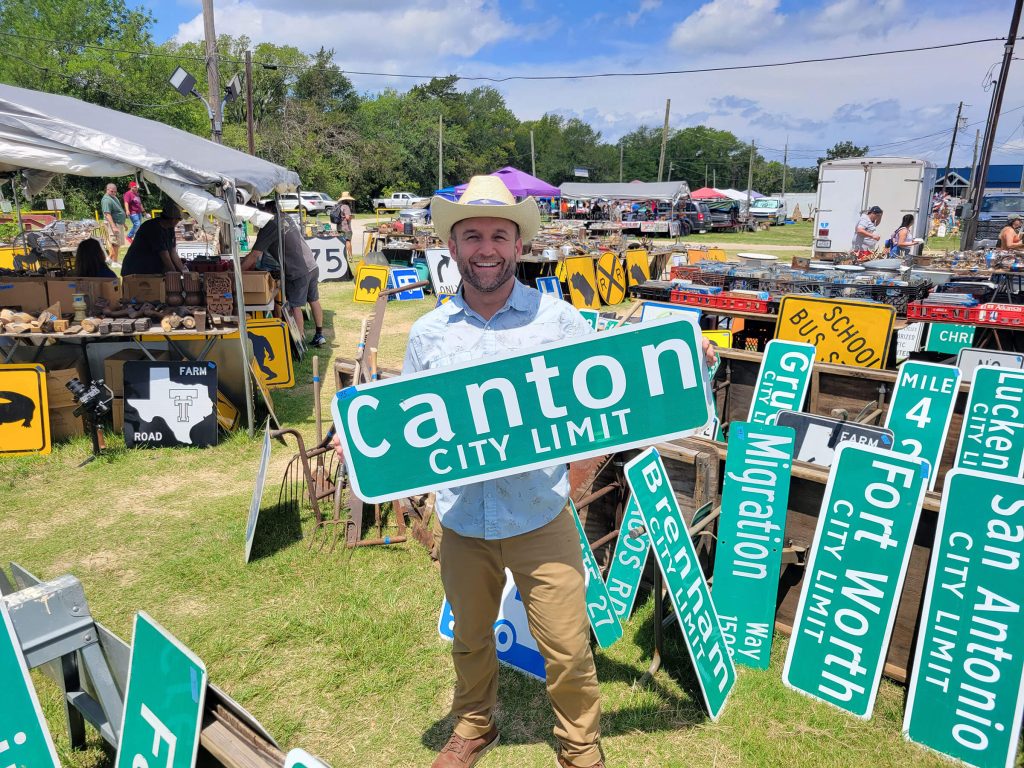


B
c
k
T
o
o
u
r
R
o
u
e
s
Seven Texas road trips that are all about the journey
Illustrations by Lulu La Nantaise


great road trip is more than getting from point A to point B. It functions as a restart button; a cruise control for the mind. But it’s also a chance to gain inspiration, connect with a corner of the world different than your own, and make lasting memories. If you want to see something outside your car window besides billboards and truck stops, alternate routes give you the real Texas. Here we provide suggestions for seven road trips that wind through backroads, small towns, natural wonders, historical markers, quirky sites, and unforgettable views. Whether you’re searching for rural charm, a history refresher, or just a cool pool of spring water to leap into, these trips encourage you to stop along the way, relish diversions, and take your time. Or maybe you don’t want anything out of a road trip other than an empty path, a warm breeze, and the sweet taste of freedom.
Either way—let’s hit the road.

Hitting Highway 31
Wco t Lonvie
Speeding through East Texas on Interstate 20 offers few traffic lights, making it the most efficient route, but it’s not very interesting. State Highway 31 between Longview and Waco is a delightful alternative that allows you to see classic, storied towns like Tyler and Corsicana up close. And since it’s a direct, as-the-crow-flies line, SH 31 is actually 10 minutes quicker than I-20 west to Interstate 35 south. It’s just impossible to drive 31 without succumbing to the temptation to stop every 30 minutes.
SH 31 is four lanes in two-lane country, cradled in lush greenery on both sides. There’s also nothing mediocre about 31’s medians, which are so broad in spots that the Navarro College Cheer team of Corsicana could use it to practice routines for its Netflix show, Cheer. You’ll pass a donut shop about every 10 miles, but you’ll also see stuff like the hand-painted sign outside a house advertising “DIVORCE: $79.99 and up,” just east of Dawson. Quirkiness has a rural address.
The trip starts about 30 miles northeast of Waco with breakfast at The Original Burrito Barn in Hubbard. Don’t homemade tortillas make everything they’re wrapped around taste great? A three-item breakfast burrito for $5.99 is all the fuel you’ll need to make it to Stanley’s Famous Pit Bar-B-Q, 100 miles away in Tyler. Not just known for ’cue, Stanley’s also serves the delicious Mother Clucker sandwich, featuring chicken, egg, candied bacon, and guacamole.

Miles: 174
Timeline: 1 day
Lodging: The Countryside Inn in Malakoff provides simple accommodations for around $55 a night. Another option is to rent a cabin on Cedar Creek Lake on vrbo.com.


Yeah, you can get your kicks on Route 66, but 31 is tons of fun. You’ll drive through six counties—McLennan, Hill, Navarro, Henderson, Smith, and Gregg–and explore such towns as Malakoff, “The Gateway to Cedar Creek Lake,” 9 miles west of Athens. The lake, a boating and fishing paradise with 320 miles of shoreline, is about 3 miles north of Malakoff. Detour to other colorfully named burgs like Log Cabin and Gun Barrel City that also hug the lakeshore. For live country music on the weekends and great chicken-fried steak, cross the lake from Gun Barrel City to Seven Points to get to Vernon’s Lakeside restaurant.
Exploring isn’t boring on a route that seemingly has more junk stores and antiques shops than gas stations. For the coolest high-school mascot T-shirts, pop into the Salvation Army in Corsicana for a Tigers top. Corsicana is worth at least an hour of exploration, especially if you’ve got kids and it’s a hot day, since Jester Park Pool charges just $3 for admission. While the tykes burn up energy, the adults can explore the adjacent Pioneer Village, which includes the Lefty Frizzell Country Museum. The music legend was born just outside of town, and his museum features a bronze statue of his likeness and his old suits and boots.
A couple of warnings about driving SH 31. First, coming west in late afternoon the sun will shine right in your eyes, which is only good if you’re working on a James Franco impression. Second, don’t take 31 in a rainstorm. I did that two years ago and have never been happier to see I-35 in my life! It took several hours for the color to return to my knuckles.
But in good weather, I’ll take any excuse to drive this highway my way.
— MICHAEL CORCORAN


Miles: 281
Timeline: 4 days
Lodging: The renovated 1930s Hotel El Capitan in Van Horn has 50 rooms (12 with private balconies), a dining room, and a bar. Rates range from $109 to $175 a night.
The Hiker’s Guide to Far West Texas
Te El aso oop
Standing on Mundy’s Gap—the namesake of Mundy’s Gap Trail in Franklin Mountains State Park—feels like catching a ride on a runaway train. From a perch high above El Paso with a bird’s-eye panorama of the surrounding Chihuahuan Desert, the vantage creates the sensation of vertigo, as if the body is moving forward and everything seems to hurtle into the horizon. The perch also reveals where you’re headed next—Hueco Tanks State Park and Historic Site, visible from about 42 miles away.
Along the drive on State Highway 62 from El Paso to Hueco Tanks, urban sprawl recedes into a rural hodgepodge of independent businesses, body shops, and taquerias. Eventually, all of it falls away as the foothills of the Hueco Mountains rise and nature takes over. On this route, you won’t see much of anything that looks like civilization again until you reach Van Horn, 140 miles away.
Hueco Tanks State Park is a favorite among rock climbers. Part of the park’s allure is its geology, a remnant dome created by hot magma that cooled beneath the earth’s surface millions of years ago. Erosion exposed it, allowing water and wind to sculpt shelves, overhangs, niches, and crevices—all ideal for bouldering—as well as bowl-like depressions called huecos (“hollows” in Spanish).
The park also houses the largest collection of rock-art face designs in North America. About 870 years ago, people now known as the Jornada Mogollon painted more than 200 mask-like faces on the rocks, possibly for religious purposes. A self-guided hike to Cave Kiva on Hueco’s North Mountain, followed by a belly-crawl beneath truck-size boulders, reveals eight of the paintings.

Frijole Ranch in Guadalupe Mountains National Park. Photo by E. Dan Klepper
Farther east along 62, the landscape blends Texas desert scrub with New Mexico chaparral, lending a Western-movie vibe to the scene. After driving 90 miles, the best view in Texas awaits in Guadalupe Mountains National Park. If you have time and energy, you can tackle the six- to eight-hour round-trip hike to the summit of Guadalupe Peak. For a less strenuous experience, the park’s Frijole Ranch offers several shorter hikes. Frijole Ranch was established in 1876 by the Rader brothers, the first documented Anglo settlers on the southeast side of the mountains. The Frijole Ranch History Museum features the trailhead for the Smith Spring Loop, a little more than 2-mile round-trip hike. Shaded and serenaded by the sound of water, Smith Spring makes a tranquil spot for a picnic and a nap.
The desert town of Van Horn lies 63 miles south via State Highway 54. The route passes between the Delaware Mountains and the Sierra Diablo, home to the state’s first reintroduced bighorn-sheep population. The road also passes Blue Origin’s rocket-launch facility, a modern structure that sticks out among the creosote and yuccas. The privately funded aerospace company is owned by Amazon founder Jeff Bezos. Blue Origin’s vertical launch-and-land spacecraft and NASA collaborations have made the company a leader in modern rocket technology. The imposing security entrance to the facility features multiple gates, a checkpoint booth, and sleek overhead lighting just off the roadway.
In Van Horn, the town’s oldest surviving structure, built in 1901, has served as a saloon, post office, county courthouse, and hotel, but is now a museum. Today, the historic building known as the Clark Hotel Museum houses curiosities like antiquated farming equipment, bonnets, and locks of braided hair.
Along Interstate 10 back to El Paso, the mountainous landscape continues to unravel. The Sierra Blanca, Eagle, Finlay, and Quitman mountains cradle the route. Once barriers to a frontier that took weeks to cross and made mad, lonely men out of pioneers, these scruffy, low-slung mountains are now Instagrammable scenery for a world traveling at Space-Age speed.
— E. DAN KLEPPER


The Other 35
Wst Clumia t Corus Crisi
Don’t be fooled by the name. State Highway 35 is the antithesis to the behemoth with which it shares a number. Interstate 35 is a white-knuckle fight for highway survival, while its country cousin is an easy cruise through green marshes and across bays, with intermittent glimpses of the Gulf of Mexico. Otherwise known as the “Hug-the-Coast” Highway, this 35 predates I-35 by more than 40 years. With only one lane on each side most of the way, it’s a quaint retreat—a throwback to Sunday drives where the journey was the destination.
This slow ride begins south of Houston in West Columbia, the tiny town with the distinction of having been the capital of the Republic of Texas for about three months in 1836. Stop by the state historical marker on the corner of Brazos and Brown streets to learn about Charlie Brown, the former slave who became the largest landowner in Brazoria County and started the county’s first school for African American children. Although much about Brown’s life is unrecorded and unknown, in 2015 the state legislature passed a resolution honoring the man whose “life and legacy are indeed worthy of tribute.” The Varner-Hogg Plantation, a state historic site just outside of town, tells stories of pioneer days, slavery, and oil.

Miles: 156
Timeline: 2 days
Lodging: The Peaceful Pelican Bed and Breakfast in Palacios is a restored Victorian home with a wrap-around porch, comfy rooms, and homemade breakfasts. Rates are about $150 a night.

The Point in Palacios. Photo by Nathan Lindstrom.
Back on the road, roll down your car windows for some Gulf breezes as 35 steers you straight toward Matagorda Bay. In the town of Palacios, home to birders and fishermen, stop at The Point. The hybrid convenience store and Vietnamese and Mexican restaurant has become the social hub of the town. “You’ll see everyone here,” co-owner Yen Tran says. “You can grab fishing gear, breakfast tacos, and authentic Vietnamese food. Everyone in Palacios ends up at The Point.” Road-trippers can dine on world-class pho and spring rolls at the same table where the late chef and TV personality Anthony Bourdain once sat, or grab takeout for a picnic on the docks overlooking the bay. If you’re lucky, you might catch the flash of a roseate spoonbill in flight.
You can keep on trucking toward Rockport, or take a 45-minute side trip to the Aransas National Wildlife Refuge. This pristine sanctuary overlooking San Antonio Bay is a landing spot for whooping cranes. Heron Flats, an easy 1.5-mile walking trail, promises glimpses of leggy birds high-stepping through marshes as they seek their supper. The natural wonders continue 10 miles north of Rockport in Goose Island State Park, where the Big Tree prevails. Scientists have calculated this live oak could be more than 1,000 years old—and it’s so resilient even Hurricane Harvey couldn’t knock it down.
Between Palacios and Rockport, it may be hard to keep your eye on the road. SH 35 crosses over the shimmery Lavaca, San Antonio, and Copano bays, where rivers meet the Gulf of Mexico. The thrill of being surrounded by blue water on all sides may require a photo stop. If you time it right, you can catch a sunset sky of pink and orange swirls at the remains of the Copano Bay Fishing Pier just as you’re cruising into Rockport.

Corpus Christi. Photo by Nathan Lindstrom.
Glow, a former sailboat repair shop turned locally sourced seafood joint overlooking the bay in Rockport, offers one of the best meals on the Texas coast. With cornhole on the patio and a nautical vibe, Glow is a cozy spot to fuel up before your last leg of the trip. All the fare is seasonal and made from scratch; the Rockport Chowder, made with local shrimp, crab, and oysters, is a specialty.
From Rockport, it’s only 28 miles to Portland, where it’s time to say goodbye to this laid-back coastal road as it merges south into the bigger US 181. Sunset Lake Park, with a 2-mile hike-and-bike trail among the wetlands of Nueces Bay, is a breezy spot to stretch your legs. The lyrics of country musician Don Williams, who was raised in Portland, suits the bayside scene: “The smell of cape jasmine through the window screen / I can still hear the soft southern winds in the live oak trees.”
Heading toward Corpus, you are thrust back into the rush of multiple lanes and cars in a hurry to get somewhere—a jolt after so many miles of traffic-free driving. The intensity of it brings to mind the other bigger, faster 35. It’s a reminder of just how good you’ve had it on the mellow ride of the coast-hugging highway.
—CLAYTON MAXWELL


Miles: 340
Timeline: 2 days
Lodging: Spend the night with the spirits of Fannin and his men at the restored Quarters at Presidio La Bahía, which once housed priests. $212 a night.
Revolutionary Road
Gnzaes T La Prte
Even for those who made A’s in seventh grade Texas History, the sequence of events of the Texas Revolution can get muddled. A road trip is a hands-on way to fill the knowledge gaps, particularly if author Stephen Harrigan is in the passenger seat. Not the actual Harrigan—unless you happen to know him—but his 925-page tome, Big Wonderful Thing: A History of Texas, published in 2019. His chapters on the revolution shine with nuance and good storytelling and, as a companion on a driving tour, can make the past feel quite present.
First stop, Gonzales, the South Texas town on the Guadalupe River where, in October 1835, the first shots of the Texas Revolution were fired. With unrest stirring, the Mexican government tried to retrieve the cannon it had loaned Gonzales’ settlers to protect themselves against attacks by Native Americans. Retrieve it they did not. Harrigan writes about how Sarah DeWitt, the widow of the area’s founding colonizer, sewed a flag out of her daughter’s wedding dress that dared the Mexicans to cross the Guadalupe River to fetch their cannon.
Those celebrated words DeWitt stitched, “Come And Take It,” now festoon countless storefronts in the quaint downtown of Gonzales. One can stop for dinner at the Come and Take It Bar and Grill or attend the Come and Take It Celebration on the town square each October. The coveted cannon stands proudly at the Gonzales Memorial Museum. With its reflecting pool, pink granite monument to the Gonzales men who died at the Alamo, and artifacts from the 1830s and before, the museum underlines how this sleepy little town was a major player in Texas history.


From there, head west through prairie land to Interstate 10—the fast track to San Antonio, where Mexican General Santa Anna’s attack against the Texian rebels at the Alamo became one of the great legends of the Lone Star State. The dark oak-paneled bar of the Menger Hotel, established in 1858 just across the street, is a cozy spot to reflect on the Alamo and read Harrigan’s tales, some of which include lesser known Alamo personalities like Juan Seguín, the Tejano leader who joined the fight, and Joe, William B. Travis’ slave, whom Santa Anna spared.
From the Alamo, it’s a 91-mile cruise southeast on US 181 through farmland to the Presidio La Bahía in Goliad. The striking Spanish fort emerges on a hill overlooking the San Antonio River. Carefully restored in the 1960s to replicate the 1749 fort with its adjacent chapel and large interior courtyard, the presidio houses a small museum in which you can learn how Col. Fannin, just 13 days after the fall of the Alamo, was defeated by the Mexican army at nearby Coleto Creek. Fannin and his more than 340 men were then marched back to this presidio and executed on Santa Anna’s orders. The Fannin Memorial just outside—a granite tower looming over a green field near where Fannin and his men were buried—makes a contemplative spot to consider the dramatic events that unfolded here.
The Goliad Massacre is heavy stuff, but history knows this trip’s not over yet. Northeast of Goliad, Sam Houston, the commander of the Texas army, found Santa Anna bivouacked by Buffalo Bayou near present-day Houston. He ordered an attack, and on April 21, in an 18-minute blitzkrieg, the Texans defeated the Mexicans, sealing Texas’ independence.
Now this hallowed ground is the San Jacinto Battle Monument and Museum. A visit there ends this journey on a high note. An elevator ride to the top of the 570-foot monument delivers views of the Houston Ship Channel as well as the marshy environs of the battle. The museum houses some of the rather intimate artifacts that Harrigan references, like Houston’s ring inscribed with the word “Honor” and his dictionary in which he scratched out the word “temporize.” Apparently Houston had issues with this word, defined as “to avoid making a decision or committing oneself in order to gain time.” Lucky for Texas, Houston did not temporize at San Jacinto.
Looking out over the oak trees here, it’s a marvel to consider that this is the same grove where Houston and his men camped on that fateful day in 1836. The scene evokes the closing words of Harrigan’s book, when he, too, is looking at an old Texas oak, one carved upon by an 18th-century Spanish friar trying to map the lands of Texas: “Like everything that now seems present and visible but is steadily being lost to the engulfing past, it was one more vestige of the Texas that used to be.”
— Clayton Maxwell

Scenic 281
Mnerl Wels t Marle Flls
The highway connecting Canada and Mexico, US 281 serves as one of Texas’ most scenic routes. This section of the road wanders through the Palo Pinto Mountains, where juniper and mesquite keep company with oak and sumac trees, to the heart of the Hill Country, crossing famous rivers like the Brazos and Colorado. Before committing to spending three days in the car, I like to start with a good workout. At Rochelle’s Canoe Rental in Graford, 19 miles west of Mineral Wells, you can rent canoes and kayaks for a 10-mile journey down the gentle Brazos River. It’s a lazy trip, as I pull over to picnic under massive spreads of ancient oak trees on the river banks. Later on, I inspect the historic Baker Hotel in Mineral Wells, which is under construction to return it to its former magnificence.
Turning south, I slow down on 281 as it crosses over the Brazos in order to admire the WPA-era steel truss bridge. Another few miles south, cruising through a rolling landscape dotted with clusters of live oak, I wheel into a gravel parking lot beside a massive rocker. The World’s Largest Cedar Rocking Chair is the landmark for Natty Flat Smokehouse near the hamlet of Lipan. The chair, noted in the Guinness Book of World Records, stands nearly 26 feet high, measures more than 12 feet wide, and weighs in at 5,672 pounds. Inside the barbecue joint, I inhale the aromas and ponder choices like smoked brisket, ribs, jalapeño sausage, and fried pie.

Miles: 240
Timeline: 3 days
Lodging: Canyon of the Eagles near Burnet provides 61 comfortable rooms that include either courtyard or lake views from porch chairs. Rooms start at $144.



As I travel the 23 miles toward Stephenville, I take note of the undulating farmland where cattle roam, giant hay bales punctuate the landscape, and goats nibble at green spots in pastures. In a freestanding barn building just outside the heart of town, I find Capital Hatters, which is the perfect place to pick out a custom straw or felt cowboy hat. I save some of my spending money for Hico, another 20 miles away. The downtown area features home décor shops like Hill Country Dwellings as well as the famous Wiseman House Chocolates, which dishes out treats like handcrafted truffles, toffee, and pecan caramel clusters.
Heading south again and eyeballing the increasingly hilly topography, I pull off in Lampasas to spend time in Hancock Springs Park. On a hot day, there’s no better place to cool off than in the Hancock Springs Free Flow Pool. This century-old pool is sourced with pure mineral water that steadily flows from a local spring, staying a cool 69 degrees. The chilly swim invigorates, and then my stomach growls and leads me toward Storm’s Drive-In Restaurant a few blocks away. The friendly counter staff hands me a burger and strawberry shake, which I take outside to eat on the patio.
Motoring from Lampasas through a scrubby and rocky Hill Country setting, I pause again just 22 miles away in Burnet. On the courthouse square, Wedding Oak Winery recently opened a tasting room where visitors can sample its reds and whites, which are made with grapes from the Texas High Plains and the Hill Country. Taking my glass of crisp albariño to the rooftop patio, I drink in the surrounding countryside.
From the town square, I follow 30 miles of twisting, climbing road that clings to the rocky shoreline of Lake Buchanan. My destination is Canyon of the Eagles Resort, where I board a cruise, reveling in views of waterfalls and wildlife living on the Colorado River’s craggy cliffs. After the cruise, I spend quiet time on the 942-acre retreat, hiking some of its 14 miles of trails. The finishing touch for the whole excursion is a slice of coconut meringue pie at Marble Falls’ Blue Bonnet Café, a home-cooking go-to since 1929. While I’m curious about the rest of this highway that ultimately connects three countries, I can’t wait to make this drive again through the loveliest parts of the state.
— JUNE NAYLOR


What's your ideal summer rad tip?
Who are you traveling with?
Family
My Significant Other
Myself


Miles: 130
Timeline: 2 days
Lodging: The Comal Inn in New Braunfels features two cottages for rent across the street from the Comal River. Rates are $90 a night and up, with a two-night minimum on weekends.
The Swimming-Hole Trail
Gorgtow to Sn Anonio
The 107-mile stretch of Interstate 35 between Georgetown and San Antonio will never be confused for a scenic highway. But if you time it right and know where to stop along the way, I-35 can be the blue water highway leading to the sweet relief of some of the coolest spring-fed swimming holes in the southwest United States. Clear, cold, and chlorine-free water awaits only a couple of miles from the highway.
Think of it as swimming-hole hopping. Intrepid swimmers can splash from Georgetown to San Antonio in a single day, or make it more of a mosey, overnighting in San Marcos or New Braunfels.
In Georgetown, just five blocks north of the downtown square, you’ll find Blue Hole. This spring-water lagoon on the South Fork of the San Gabriel River is bordered by limestone bluffs. There is plenty of shallow water for the kids to play in and deeper stretches for long-distance lap swimming.
But don’t splish-splash in Georgetown too long. Barton Springs, the crown jewel of Austin, is calling, 31 miles south. Located in Zilker Park, southwest of downtown, Barton Springs is open year-round for swimmers. Its constant 68-degree water makes it the best place in the city to cool down during the long summer season. The massive pool spans 3 acres and accommodates more than 800,000 swimmers annually. The interpretative exhibit Splash! Into the Edwards Aquifer at the Beverly S. Sheffield Education Center demonstrates how the springs work.
From there, it’s 30 miles down I-35 to San Marcos, home of San Marcos Springs, the second largest freshwater springs complex in Texas. The springs feed the San Marcos River, whose chilly waters are a favorite with the tubing crowd. Rio Vista Park, less than two miles downriver, is the town’s most popular gathering spot for tubers, swimmers, floaters, stand-up paddlers, canoers, and kayakers, all of whom wait their turn to slide down the rapids in the middle of the dam.
After filling up on Tex-Mex at Herbert’s Taco Hut around the corner from Rio Vista Park, continue south for 20 miles to New Braunfels. There’s no need to joust with the masses at Schlitterbahn or risk scrapes on the city-owned Comal River Tube Chute waterslide. The Landa Park pool is the aquatic attraction less visited. Located near Comal Springs, it’s the largest complex of freshwater springs in Texas. The pool, constructed in the early 1900s, has concrete embankments like Barton Springs and is one of the oldest bathing pools in the state. Amenities include a fountain, rope swing, climbing-rope net, and waterslide. The spring-fed pool is complemented by an adjacent Olympic-size pool with chlorinated water.
The tour ends at historic San Pedro Springs in San Pedro Park, the oldest public park in Texas. Human occupation around the springs, just northwest of downtown San Antonio, dates back as far as 12,000 years. Many of the springs had already dried up in the late 19th century as a result of artesian wells being drilled for municipal use, but the San Pedro Pool was built in 1922 and thrived through the 1940s until the springs went completely dry. Heavy rains in the 1990s, an extensive renovation and restoration of the pool, and aggressive conservation efforts have brought the spring-fed pool back to its glory days, attracting summer crowds to its cool waters under the splendid shade of massive cypress trees.
Utilizing Central Texas’ bounty of swimming holes in the summertime is just the natural thing to do.
— JOE NICK PATOSKI

Gateway to the West
Wchia Fals t Odesa
The Wild West has long been romanticized in history and popular culture. While you still may encounter Longhorns, wildcatters, and cowboys, the West of today is quite different from the West of John Wayne flicks. This expedition, cutting a southwestern path from the Red River to the Permian Basin, courses through rugged country with more than its share of historical curiosities and downright oddities. One example is right in downtown Wichita Falls: The World’s Littlest Skyscraper, standing 40 feet tall, 10 feet wide, and 18 feet deep. Its creator, thought to be a con man, fooled investors with blueprints that showed misleading dimensions, and the ruse wasn’t discovered until the building’s completion in 1919. By then, the man and the money had vanished over the horizon.
Cruising south on State Highway 79, the bibliophile in me wants to make a stop in Archer City. Booked Up, in the heart of town, is a bookstore owned by Pulitzer Prize-winning author Larry McMurtry. He opened the original nearly 50 years ago in Washington, D.C., and the Archer City version debuted after McMurtry moved back to his birthplace in the 1980s. The cramped old store, with floor-to-ceiling shelves in tight rows, takes up half a block with more than 150,000 volumes of literature, poetry, and plays. I settle into an old wooden school desk next to a window and spend a couple of hours flipping through finds. Also located in the square, the lovingly restored Royal Theater, which inspired McMurtry’s 1966 book The Last Picture Show, hosts movies, concerts, and plays.

Miles: 315
Timeline: 3 days
Lodging: At Hotel Settles in Big Spring, 65 rooms and suites provide luxurious stays, while the bar and grill on the ground floor serves everything from nachos to steak. Take a swim in the patio’s pool after a day of driving, or book a massage in advance. Rooms start at $189 a night.

Desiring to delve more deeply into the past, I make Fort Griffin State Historic Site—67 miles southwest along US 283—my next stop. The fort was originally built to protect West Texas settlers in the mid- to late-1800s. I explore what’s left of the mess hall, barracks, officers’ quarters, and bakery, which are now stone ruins framed by cactus, hardy mesquite, and old elms. The fort is also home to about 200 docile members of the Official State of Texas Longhorn Herd. Seeing the magnificent beasts up close is a Texas rite of passage. It’s only another 15 miles south to Albany, where I take half a day to explore The Old Jail Art Center. As one of the nation’s great small art museums, it displays works by Modigliani, Toulouse-Lautrec, and Renoir, as well as remarkable pre-Columbian and Asian art.

Opal’s Table in Midland. Photo by Justin Rex.
In Sweetwater, about 75 miles west of Albany through flat, dusty plains punctuated by forests of wind turbines, strangers become my friends the minute I take a seat inside Allen’s Family Style Meals. Diners sit shoulder-to-shoulder at community tables inside the no-frills dining room. During the lunch rush, we pass each other platters piled high with golden-brown fried chicken and bowls of potatoes, squash, okra, green beans, salad, and peach cobbler. Another 67 miles west along Interstate 20, the big red sign of Hotel Settles welcomes me—at this point road-weary and stuffed—to Big Spring. The elegant, 15-story landmark seems out of place here, but it was originally built during the oil boom days. Like everyone who wanders here, I’m enamored with the glamour restored by the hotel’s six-year multimillion-dollar renovation.
Driving even deeper into oil country, I stop to wander the sidewalks of downtown Midland. On one corner by the convention center, the Micro Market features a collection of shops offering everything from clothes and accessories to elaborately decorated doughnuts from SisterDough. A block from the market is Opal’s Table, a charming restaurant serving fried sweet potatoes with whipped goat cheese, crab cakes with remoulade sauce, and seared tuna with cilantro-lime vinaigrette. I indulge in a nightcap at The Basement, a sophisticated cocktail and cigar bar located below the restaurant.
As I head another 30 miles west from Midland to the far side of Odessa, the stark landscape hints that things are about to get a bit weird. The Odessa Meteor Crater Museum shares the story of a 600-foot-wide crater found on-site. Geologists theorize the object—formed by tons of meteoric material—crashed there up to 60,000 years ago. It’s the place where outer space and wide-open space meet.










